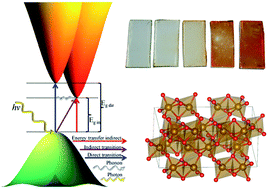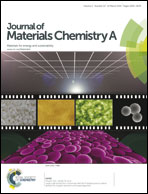Optical quantum confinement in low dimensional hematite†
Abstract
Hematite is considered to be a promising material for various applications, including for example photo-electrochemical cells for solar hydrogen production. Due to limitations in the charge transport properties hematite needs to be in the form of low-dimensional particles or thin films in several of these applications. This may however affect the optical properties, introducing additional complications for efficient design of photo-active devices. In this paper the optical absorption is analyzed in detail as a function of film thickness for 35 thin films of hematite ranging between 2 and 70 nm. Hematite was deposited by atomic layer deposition on FTO-substrates using Fe(CO)5 and O2 as precursors. It was found that for film thicknesses below 20 nm the optical properties are severely affected as a consequence of quantum confinement. One of the more marked effects is a blue shift of up to 0.3 eV for thinner films of both the indirect and direct transitions, as well as a 0.2 eV shift of the absorption maximum. The data show a difference in quantum confinement for the indirect and the direct transitions, where the probability for the indirect transition decreases markedly and essentially disappears for the thinnest films. Raman measurements showed no peak shift or change in relative intensity for vibrations for the thinnest films indicating that the decrease in indirect transition probability could not be assigned to depression of any specific phonon but instead seems to be a consequence of isotropic phonon confinement. The onset of the indirect transition is found at 1.75 eV for the thickest films and shifted to 2.0 eV for the thinner films. Two direct transitions are found at 2.15 eV and 2.45 eV, which are blue shifted 0.3 and 0.45 eV respectively, when decreasing the film thickness from 20 to 4 nm. Low dimensional hematite, with dimensions small enough for efficient charge transport, thus has a substantially lower absorption in the visible region than expected from bulk values. This knowledge of the intrinsic optical behavior of low dimensional hematite will be of importance in the design of efficient photo-active devices.


 Please wait while we load your content...
Please wait while we load your content...